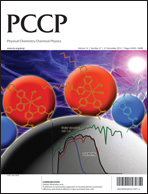A new ab initio potential energy surface for the collisional excitation of O2 by H2
Abstract
We present a new four dimensional (4D) potential energy surface for the O2–H2 system. Both molecules were treated as rigid rotors. Potential was obtained from the electronic structure calculations using a partially spin-restricted coupled cluster with the single, double and perturbative triple excitations [RCCSD(T)] method. The four atoms were described using the augmented correlation-consistent quadruple zeta (aug-cc-pVQZ) basis sets. Bond functions were placed at mid-distance between the O2 center of mass and the center of mass of H2 for a better description of the van der Waals interaction. Additionally, at five characteristic geometries, we calculated perturbational components of the interaction energy using the Symmetry-Adapted Perturbation Theory [SAPT] approach to explain the anisotropy of the potential energy surface. Bound states of the O2–H2 van der Waals complex are computed using this potential. Close coupling calculations of the inelastic integral cross sections of O2 in collisions with para-H2 and ortho-H2 were also calculated at low energies. After Boltzmann thermal averaging, rate coefficients were obtained for temperatures ranging from 5 to 100 K. No significant differences exist between para- and ortho-H2 results.


 Please wait while we load your content...
Please wait while we load your content...